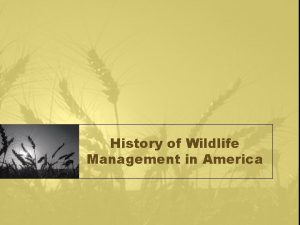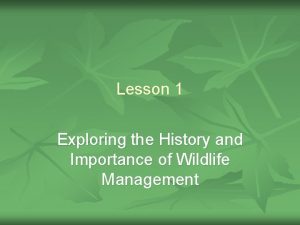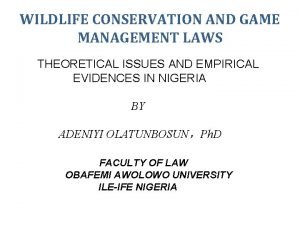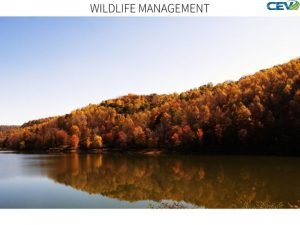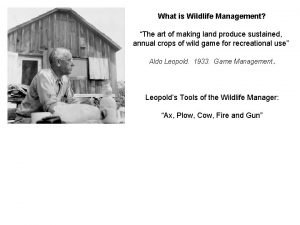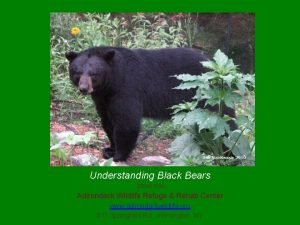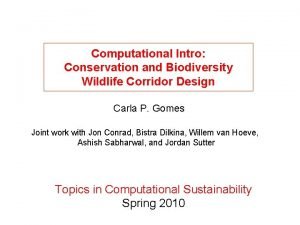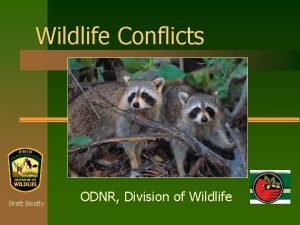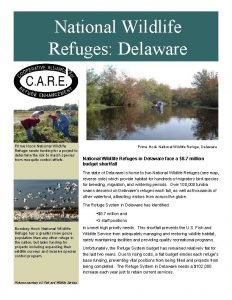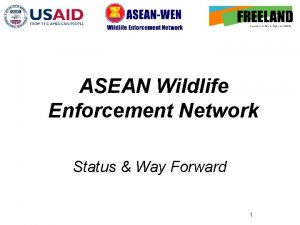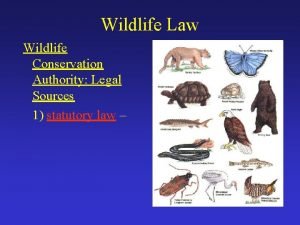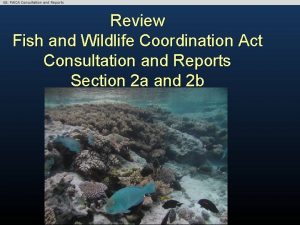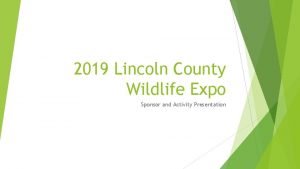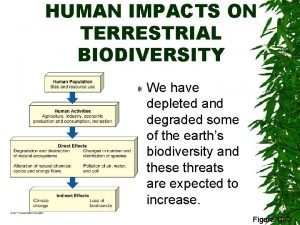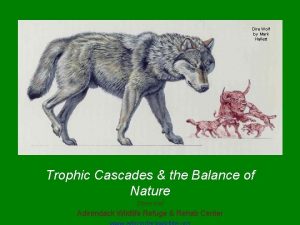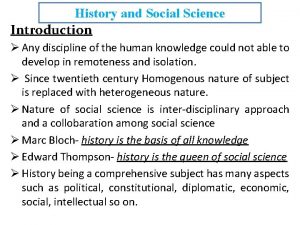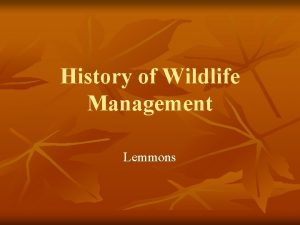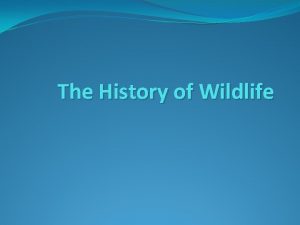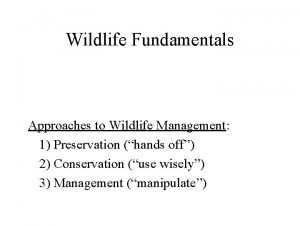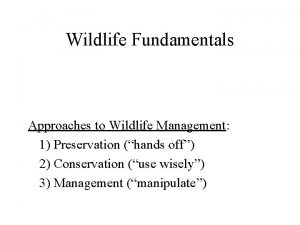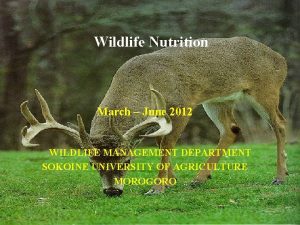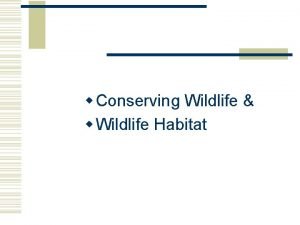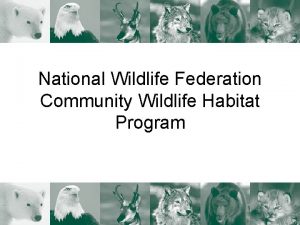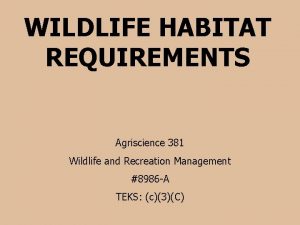HISTORY OF WILDLIFE MANAGEMENT 8982 A Introduction Wildlife












































- Slides: 44

HISTORY OF WILDLIFE MANAGEMENT #8982 -A

Introduction • Wildlife management evolved into the care of both flora and fauna. • Early wildlife management excluded plants and focused only on animals.

• Civilization changed the way people viewed wildlife. • Still there were no controls on the taking of game. • Landowners managed game only for social or recreational hunting. • The poor were charged with poaching and faced severe penalties.

• Even with the settling of America, hunting had little or no regulations. • Not until 1850 did Americans begin to show concern for animal populations. • At that time, game management became an issue for government action.

To maintain quality and quantity of animal species, wildlife management followed an order of events: • restriction of hunting, • predator control, • land was set aside as a safe place for wildlife, and • artificial replenishment or restocking.

B. C. and Historic • A form of game management dates back to the beginning of human history. • This group of people was known as hunters and gatherers. • Still, they knew they could not take food for granted.

• Self-imposed laws for hunting had their origin in early tribal restrictions. • The success of these hunting customs evolved into some of our current game laws.

Late 13 th Century The first clear record of game management came from Asia under the rule of Kublai Khan, the Mongol emperor of the Yuan Dynasty.

Some of the management practices included the following activities: • prohibited killing of certain game animals between March and October, allowing time for animals to reproduce, • punishment for those that disobeyed the hunting regulation,

• game preserves, • food patches, and • complete winter-feeding and cover control.

• In Europe, from the 1200’s to the 1800’s, people had not learned to control food and cover for wildlife. • Management was primarily regulatory. • During this age, regulation was mainly for recreational activity for the upper classes of society. • The poor still depended on hunting and gathering food for their survival.

• Management for conservation began with Edward, Duke of York, in the early 1400’s. • In the late 1400’s, law granted landowners protection from trespass for hunting.

• With the discovery of the New World, settlers found an abundance of resources that they could use however they wanted. • This marked the beginning of recorded eras of management in American history.

The five recognized eras are • The Era of Abundance (1600 - 1849), • The Era of Overexploitation (1580 - 1899), • The Era of Protection (1900 - 1929), • The Era of Game Management (1930 - 1965), and • The Era of Environmental Management (1966 present).

Era of Abundance ( 1600 - 1849) • The first settlers to Jamestown, Virginia, in 1607, did not have any working survival skills. • As the colonization of America progressed, conservation was the last thing on the minds of settlers. • They were concerned with their own survival.

• During this era, there were few legal actions to protect endangered species. • The first hunting legislation was passed in 1646. • It established a closed hunting season for whitetailed deer.

• In 1708, the first closed season for game birds was established. • Other legislation also was passed, but did little to offset the decline of wildlife.

Era of Depletion or Overexploitation (1850 – 1899) Most noteworthy for this era was the destruction of vast herds of bison (buffalo). Image courtesy of Yellowstone National Park, National Park Service, DOI.

Photo courtesy of Yellowstone National Park, National Park Service, DOI.

One species that had occurred in the billions and was brought to extinction was the passenger pigeon. Image by Richard Lake courtesy of Yellowstone National Park, National Park Service, DOI.

• The dilemma of these two species (bison and passenger pigeon) brought conservation to the attention of the public. • By 1880, all states had game laws. • These laws were still directed at wild animals.

In 1872, legislation identified Yellowstone as the first national park. Courtesy of Yellowstone National Park, National Park Service, DOI.

Photo by J. Schmidt courtesy of Yellowstone National Park, National Park Service, DOI.

• This legislation was part of the Conservation Movement of the late 19 th Century. • Timber, forage, and water resources were not directly involved in these legislations. • Animals also lacked the protection they needed.

The movement focused more on preserving scenic areas. Photo by George Marler courtesy of Yellowstone National Park, National Park Service, DOI.

Big game animals (elk, bison, and deer) had already been eliminated from most of the west and predators (wolf, cougar, and bear) were rapidly disappearing. Photo by Ed Austin and Herb Jones courtesy of Yellowstone National Park, National Park Service, DOI. Photo by Bryan Harry courtesy of Yellowstone National Park, National Park Service, DOI.

• Wildlife organizations began to develop to promote wildlife species. • Two such organizations were • Boone and Crockett Club founded by Theodore Roosevelt, George Bird Grinnell (Field and Streams magazine), and others; and • Audubon Society proposed by George Grinnell.

Era of Preservation and Production or Protection (1900 – 1929) • The Lacey Act (1900) lead the way in not only protecting wildlife, but also habitat. • Among other restrictions, this act limited market hunting by making it a federal offense to transport illegally killed game from one state to another.

President Theodore Roosevelt was the first president to actively work to improve wildlife management. Photo courtesy of Yellowstone National Park, National Park Service, DOI.

Roosevelt’s personal philosophy focused on four main parts • Outdoor resources as important systems, • Conservation as public responsibility, • Private resource ownership as a public trust, and • Science used for resource management.

• His ideology laid the groundwork for wildlife conservation in the United States. • Roosevelt’s work lead to the development of the National Wildlife Refuge System. Photo courtesy of Yellowstone National Park, National Park Service, DOI.

Era of Harvest and Habitat or Game Management (1930 – 1965) • When funding became necessary for purchase of wetlands for water fowl, wildlife research, or support for fisheries projects and research, legislature passed acts that provided funds for these activities.

The following activities were funded by grants: • Wildlife research and management was funded by Pittman-Robertson Act also called the Federal Aid in Wildlife Restoration Act, • Purchase of wetland habitat for waterfowl was funded by the Duck Stamp Act, and • Fisheries projects and research were funded by the Dingell-Johnson Act.

• These acts provided funds through the sale of hunting and fishing licenses and stamps. • There were several notable people whose influence and actions helped bring about improvements in environmental conservation.

Aldo Leopold, recognized by many as the founder of American wildlife management, was the author of Game Management and was a game management professor at the University of Wisconsin.

Franklin D. Roosevelt As the 32 nd President of the United States (1933– 1945), Franklin D. Roosevelt began the first North American Wildlife Conference in 1936, which started the Wildlife Society.

Jay Norway “Ding” Darling • J. N. “Ding” Darling was a political cartoonist from Iowa, who became director of the Bureau on Biological Survey. • He proposed the idea of the Duck Stamp Act. Photo by Sioux City Journal courtesy of U. S. Fish and Wildlife Service.

Key Pittman and Willis Robertson U. S. Senators Key Pittman and Willis Robertson sponsored the Federal Aid in Wildlife Restoration Act of 1937, also known as the Pittman-Robertson Act. Key Pittman Willis Robertson Photos by U. S. Senate Historical Office courtesy of U. S. Fish and Wildlife Service.

Senator Dingell and Representative Edwin Johnson Senator Dingell and then-Representative Johnson sponsored the Sports Fish Restoration Act, also known as the Dingell-Johnson Act, that established a federal excise tax on sport fishing equipment. Edwin Johnson Photo by U. S. Senate Historical Office courtesy of U. S. Fish and Wildlife Service.

Rachel Carson • Rachel Carson was an aquatic scientist who worked with what is now the U. S. Fish and Wildlife Service. • Carson wrote Silent Spring, which dealt with the impact of unregulated pesticide use on humans and wildlife. Photo courtesy of U. S. Fish and Wildlife Service.

Era of Environmental Awareness or Environmental Management (1966 – Present) • In 1966, Congress passed the Endangered Species Act. • This act was amended in 1969, 1973, and 1978.

• The Endangered Species Act and its amendments allowed the Secretary of the Interior to identify endangered and threatened species. • The acts gave state and federal agencies the power to provide positive impact on threatened or endangered species and to help restore their populations.

• Non-game species received regulation and management under the Non-game Wildlife Act of 1980.

ALL RIGHTS RESERVED Reproduction or redistribution of all, or part, of this presentation without written permission is prohibited. Instructional Materials Service Texas A&M University 2588 TAMUS College Station, Texas 77843 -2588 http: //www-ims. tamu. edu 2006
 History of wildlife management
History of wildlife management History of wildlife conservation
History of wildlife conservation Introduction of wildlife conservation
Introduction of wildlife conservation Manipulative management wildlife
Manipulative management wildlife Objectives of wildlife management
Objectives of wildlife management Careers in wildlife management
Careers in wildlife management Wildlife management as an art
Wildlife management as an art Adk wildlife refuge
Adk wildlife refuge Snowfall torrente
Snowfall torrente Natural vegetation and wildlife in karnataka
Natural vegetation and wildlife in karnataka Role of wildlife conservation
Role of wildlife conservation Wildlife topics for presentation
Wildlife topics for presentation Basic requirements of wildlife
Basic requirements of wildlife Shillapoo wildlife area
Shillapoo wildlife area Wildlife corridor design
Wildlife corridor design Wildlife reproduction
Wildlife reproduction Cascade mountains wildlife
Cascade mountains wildlife Odnr division of wildlife
Odnr division of wildlife Boreal shield vegetation
Boreal shield vegetation Spoil wildlife
Spoil wildlife Prime hook national wildlife refuge map
Prime hook national wildlife refuge map Blackwater national wildlife refuge hunting
Blackwater national wildlife refuge hunting Asean wildlife enforcement network
Asean wildlife enforcement network Adirondack wildlife refuge
Adirondack wildlife refuge Wildlife conservation law
Wildlife conservation law Fish and wildlife coordination act
Fish and wildlife coordination act Wildlife adalah
Wildlife adalah Diane boyd wildlife biologist act answers
Diane boyd wildlife biologist act answers Wildlife biologist
Wildlife biologist Fielders pro shop brookhaven ms
Fielders pro shop brookhaven ms Renowow
Renowow Cotswold wildlife park
Cotswold wildlife park Arctic national wildlife refuge oil drilling pros and cons
Arctic national wildlife refuge oil drilling pros and cons Which is a nonrenewable resource? soil fish wood coal
Which is a nonrenewable resource? soil fish wood coal Necedah wildlife refuge map
Necedah wildlife refuge map Frac pond liner
Frac pond liner Impacts of wildlife trade on terrestrial biodiversity
Impacts of wildlife trade on terrestrial biodiversity Adk wildlife refuge
Adk wildlife refuge Montane cordillera wildlife
Montane cordillera wildlife Also history physical
Also history physical Top management middle management first line management
Top management middle management first line management Top management middle management first line management
Top management middle management first line management Top management and middle management
Top management and middle management What is history in social science discipline
What is history in social science discipline Introduction to history of education
Introduction to history of education
